|
Displaying items by tag: japanese
The Crocker Museum served as a storage space for precious pieces of artwork for Japanese families during WWII.
The museum says it recently discovered the it kept precious items for several families sent away to relocation camps, and is now trying to track down those families.
Registrar John Caswell says he recently discovered in old archived documents that the Crocker Museum once served as storage space for Japanese-American families forced into war relocation camps back in 1942.
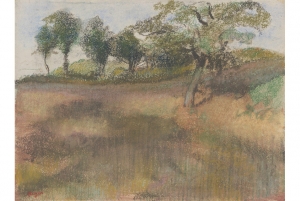
Boston-based collector, Dorothy Braude Edinburg, has gifted nearly 1,000 works of art to the Art Institute of Chicago, making it one of the most significant donations in the museum’s history. The gift includes approximately 800 works on paper – primarily European prints and drawings from Old Mast to modern – and 150 works of Asian art. The donation will complement the considerable long-term loans and prior gifts made by Edinburg including works by Vincent van Gogh (1853-1890), Paul Gauguin (1848-1903), Pablo Picasso (1881-1973) and Henri Matisse (1869-1954).
The most recent gift, along with Edinburg’s previous donations, is part of the Harry B. and Bessie K. Braude Memorial Collection, which honors Edinburg’s parents. Highlights include nearly 50 extremely rare Japanese volumes, many of which are from the Edo period, a sorely unrepresented period in American museum collections; Chinese celadons from the 12th and 13th centuries; and prints and drawings by Edgar Degas (1834-1917), Claude Monet (1840-1926), Edvard Munch (1863-1944) and James McNeill Whistler (1834-1903), among many others.
Edinburg said, “I have never thought of my collection as a personal endeavor. I have always believed that it should ultimately enter a major museum and serve a broad public…I have seen the Art Institute as the eventual home for my entire collection for many years, and I am thrilled to taking another step forward with this gift in honor of my parents.”
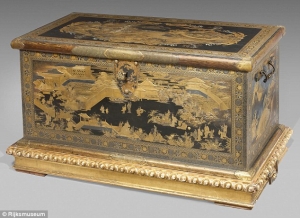
The Rijksmuseum in the Netherlands purchased a rare antique Japanese chest once used as a television stand for $9.5 million. London’s Victoria and Albert Museum had been searching for the 17th century lacquer chest, one of only ten in the world, since 1941.
The saga of the chest began in 1640 when the head of the Dutch East India Company’s Japanese office commissioned the chest along with three others just like it. All four of the chests were later sold to a French diplomat who passed two of the works off to the British poet William Beckford. Beckford, whose daughter was married to the Duke of Hamilton, inherited the chests and they became part of the Hamilton Palace’s collection. During a sale in 1882 to raise funds for the palace’s upkeep, the Victoria and Albert Museum purchased one of the chests while the other eventually went missing. What the museum didn’t know was that an unassuming Shell Oil engineer had purchased the missing chest in 1970 for a mere $150. The elusive chest was used as everything from a television stand to a storage cabinet until auctioneer Philippe Rouillac and his brother, Aymeric, recognized it.
While the Victoria & Albert Museum would have liked to have been able to bid on the chest when it went to auction, they simply didn’t have the funds. Julia Hutt, curator of the V&A’s East Asian department, said, “I was delighted to hear the Rijksmuseum had won the auction – it is a very fitting home for the chest.”
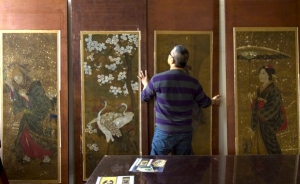
Six 140-year-old Japanese silk paintings by Utagawa Kunitsuru have undergone major restoration thanks to Washington, D.C.-based conservator, Yoshi Nishio. The paintings, which measure about 6 feet tall and 21 ½ feet wide, were previously hung in the Decatur House, a historic home and functioning museum, which serves as the National Center for White House History. The Decatur House is located across Lafayette Square from the White House and was designated a U.S. National Historic Landmark in 1976.
The paintings are believed to have been created in 1873 during a time of rich cultural exchange between Japan and the United States. The leading theory suggests that President Ulysses S. Grant acquired the works when he visited Japan in 1879 as part of a world tour. Only one of the six paintings is signed and dated.
The works have hung in the Decatur House for over a century and years of smoke, sunlight, and moisture had left the paintings wrinkled and darkened. Nishio, who received the paintings last year, spent hours cleaning the works with water, solvents, cotton swabs, and bamboo brushes with sable bristles. He worked on particularly delicate portions of the paintings with a scalpel under magnification. The paintings also had to be immersed in water to separate them from the boards they had been glued to.
The paintings, which feature a geisha, a robed samurai, white cranes, cherry blossoms, and a long-tailed rooster, are expected to return to the Decatur House in June 2013.
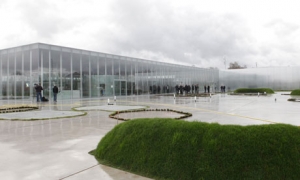
In response to critic’s who say French art is elitist, the Louvre has embarked on the “Louvre-Lens” project and have built an extension of the museum in the poor mining city located in northern France. The project, which opens this week, is housed in a glass and aluminum structure and stands in stark contrast to the rest of the impoverished area.
While the Louvre is well intentioned, locals are wary. French President, Francois Hollande, visited the museum on December 4 but failed to venture outside the institution’s walls. While art is welcome, locals feel they are in greater need of expanded job opportunities and a more stable economy. Still, the Louvre hopes that they can help transform Lens similarly to how the Guggenheim Museum turned the burned-out, industrial city of Bilbao, Spain into a travel destination.
Lens was leveled as a result of World War I and II. After that, the city spent decades as mining area and endured many related tragedies. After the last mine closed in 1986, the city fell into poverty. Now one of the country’s poorest cities, Lens has an unemployment rate of 24 percent; the national average is 9 percent.
Designed by a Japanese firm, the museum boast two large exhibition spaces and features a diverse body of work including Cycladic sculptures, Egyptian statues, 11th century Italian mosaics, and Leonardo da Vinci’s restored masterpiece, The Virgin and Saint Anne.
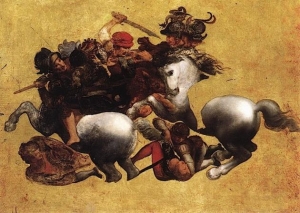
A division of the Italian police department that specializes in art thefts has located a 400-year-old copy of a lost Leonardo da Vinci fresco. Depicting the Battle of Anghiari, the masterpiece was never finished.
The copy, widely known as the Tavola Doria, once adorned a wall of Florence’s city hall, the Palazzo Vecchio, and illustrates a historic battle between Florence and Milan that took place in 1440. It is believed that da Vinci experimented with various fresco-painting techniques before he started work on the battle scene in 1503. Despite his efforts, the paints began to drip and da Vinci was never able to finish the fresco. Over the next few years, the piece deteriorated and the Italian painter, Giorgio Vasari, was commissioned to paint over what was left of the incomplete fresco.
Since the unfinished da Vinci painting no longer exists, copies of the lost artwork are extremely important to art historians and scholars. This particular copy, painted on a small wooden panel, was last seen in public 73 years ago at a Leonardo da Vinci exhibition held in Milan on the eve of World War II. After the exhibition, the work disappeared.
Experts have since determined that the panel was stolen from its owners in Naples and ended up in the hands of a Swiss art dealer. The work was sent to Germany for restoration in the 1960s, made a brief appearance in the 1970s at an art gallery in New York, and by the 1990s was the property of a wealthy Japanese art collector.
Finally back in Italy, the Tavola Doria will be on view at Florence’s Uffizi Gallery during 2013. The work will then spend four years in Japan as part of a loan agreement worked out with the Fuji Art Museum in Tokyo, where it was last exhibited.
|
|
|
|
|